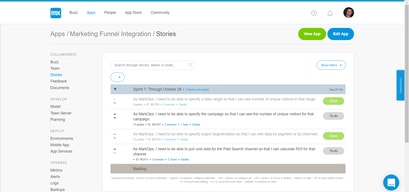

Unclaimed: Are are working at Mendix ?
Mendix Reviews & Product Details
Mendix is a cloud-based app development platform designed to help users build apps easily via a SAP cloud platform. It has key features that include visual development, multi-channel apps, proactive and context-aware app management, development and operations (DevOps), multi-cloud deployment, security, open and extensible integrations, AI-assisted development, and more. It also allows users to empower real-time collaboration and develop applications with experimentation, iteration, and collaboration of different units.

| Capabilities |
|
|---|---|
| Segment |
|
| Deployment | Cloud / SaaS / Web-Based, Desktop Windows, Mobile Android, Mobile iPad, Mobile iPhone, On-Premise Linux, On-Premise Windows |
| Support | 24/7 (Live rep), Chat, Email/Help Desk, FAQs/Forum, Knowledge Base, Phone Support |
| Training | Documentation |
| Languages | English |






Compare Mendix with other popular tools in the same category.

The platform has given us the power to win the UWV/ SVB of oktober 2017 with Mendix. Within 24 hours we wore able to build the 1st solution. With its great standard features, and powerful extension capabilities in the form of building custom widgets we have made a single page app that was connected to Microsoft Face recognition, Google Speech to text and many more external services.
You need to be a fullstack programmer to truly capture and also understands its power. Its not for the business user, but for the professional who wants to develop at lightning speed.
Mendix allowed us to make an MVP (a Proof of Concept) in less then 24 hours. That is architectural designed with security first in mind. Capable to be used in a high demanding and high available IT environment.
It's relatively easy to build a working application and roll out to production, without any form of coding. Building with modularity in mind makes components highly reusable, including lots of building blocks available through an app store.
Not all app store apps are maintained well enough to keep working. Especially for the components built by Mendix itself, this is sometimes disappointing.
We were able to build applications for lots of different business processess that depend on data usage and interaction. Especially with data intensive applications, Mendix becomes really useful to replace numerous other applications, often built in Excel or Access. Eliminating user errors and errors in maintainability, while building and deploying way faster than traditional development can achieve.
From first setting up your project until having a running web application in the mendix cloud is a matter of hours.
The 'no-coding' marketing bubble by Mendix suggesting you don't need developers anymore.
We deliver integrated web-applications as extenesion to our customers existing CRM or ERP systems. With Mendix we can react much faster to changing requirements.
I've been working with the Mendix platform for 6 years now, and still find its easy to learn, hard to master developers user interface great. The built-in real-time model checking features are top notch, omnichannel development (develop functionality once, create a desktop/tablet/mobile app in a snap), ease of setting up integrations with other systems are great. The Mendix community, with its active developers and knowledge meetups is fantastic, anyone can learn almost an infinite amount of things in no time.
What could be improved upon is Mendix' document generation mechanism. It turns a graphical template into XSL-FO, which outputs PDFs, Docx, etc, but a simple change in the template requires an entire restart of your application. A 'generate preview document' button would be much better.
Creating business value for our customers. Helping them work better, faster, more efficient. Putting smiles on the faces of our end users and wowing them with fantastic looking apps, developed in days instead of weeks. Being able to change the application on the fly, stunning customers who have bad experiences with traditional development methods.
I am coming form a business (Accounting) background and could easily understand the coding logic. It really makes it simple to understand and to implement solutions.
It takes some time understading what Mendix does and what is does not. you as a developer must know where to take over.
Using Mendix we can rapidly deploy systems and therefore, minimizing time to market.
It doesn't require tons of programming knowledge to build an application. Despite the default professional-looking styling, it's really handy to edit the styling as well!
Some documentations could be added and the idea forums could be used as a reference more often.
Data integration.
The fact that I can sit down with an end user and create their perfect application together with them in a single sit.
The license system is focused on medium to big firms, whereas the pricing model often is unfavorable for a small firm only needing a single small application.
There is no limit to the problems that can be addressed and solved, from client facing to back-end, with no limit on industry. Benefits are realised for all parties involved, both at the client and customer side.
Low-code rapid development in an easy to use modeler with default great designs
Nothing, really. I have submitted a few improvement requests in the past, but they are all implemented already.
We provide businesses with supply chain portals, inventory management, customer relations management and product information management.
ease of use, easy to leran, build high scale application in a small time manner.
not yet, i didnt find any issue through development phase.
eServices. CRM.
Integration with other web services, especially SOAP based, but also other RESTful services, is extremely streamlined. Data structures and web service calls are auto-generated, and sending of files via different protocols is supported without any extra effort.
The App Store is critical to meeting customer expectation, because it features hundreds of ready-to-use components. The problem is that some of the components are not-updated regularly by their owners, and since Mendix is not the owner, support for these components is hard to come by.
Our company uses Mendix to empower customers to digitilize their business model and innovate in the digital realm by providing new, unique and competitive features. So far I have participated in three projects for three separate customers. For all of them, we have been able to deliver beautiful and functioning apps in record times, reducing the time from idea to production ready application to just a few months.







